8 Games and Apps Training and Learning Professionals Should Try
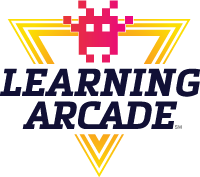 Our smartphones are fully embedded into our lives today. They are rapidly becoming a natural extension of everything we do, including entertainment, social interaction, productivity, and yes, even learning.
Our smartphones are fully embedded into our lives today. They are rapidly becoming a natural extension of everything we do, including entertainment, social interaction, productivity, and yes, even learning.
We spend so much time-consuming information that we often forget to step back and consider why we consume what we do, and how the games and apps we play are designed to support that consumption. The apps we use every day are designed to provide a certain type of experience, and some deliver upon it very well.
Looking at Games and Apps Differently
As a learning and performance professional, I try to force myself to step back from consuming an experience so I can look at its design, asking myself questions like:
- Why was this built the way it was?
- How is the game teaching me how to play?
- What support is available if I hit a road block?
- How is the design supporting the advancement of my skills?
Looking at the games and apps I use every day through this lens can often inspire ideas and approaches that can be used in my work in building learning programs. I try to do this often, especially with experiences that I find new and unique.
Here are a few games and apps that I would recommend every learning professional try. Even if the game or experience doesn’t interest you, try them out to examine the approach, and how it can be transferred to your work.
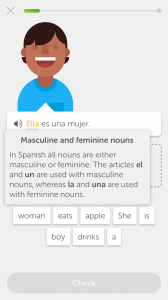 Duolingo
Duolingo
Duolingo is a popular language learning app. Even if you aren’t interested in learning a new language, this app is a great example of “rethinking the course”, as the courses are built on interactive exercises designed with the short-burst paradigm of mobile consumption in mind. In a world where buzzwords like “microlearning” are becoming increasingly popular, examples like Duolingo are a great example of rethinking what a course or curriculum might look like.
Netflix
This may seem like a strange one to add to the list, but I add it because of another buzzword that is growing in our industry – personalization. Netflix is a great example of what personalization looks like to the end-user. Netflix allows you to make selections to start personalizing what it recommends, learns from your usage to suggest increasingly relevant content, and packages it all into an experience that follows you seamlessly across all devices – start watching a movie in the living room, continue watching on your iPad in bed, and finish the next morning on your phone while on your commute. Using this app may not teach you how to technically build a personalized learning experience, but it will definitely help you understand the concept of what personalization can look like.
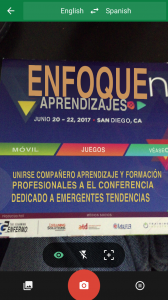 Google Translate
Google Translate
Augmented reality is a rapidly growing field, and one that has tremendous applications for learning. What the conversation in learning has been lacking so far are wide-ranging tangible examples that show learning and performance support via AR in action. It’s those examples that help make the value of AR for learning real. Google Translate is a great example of this. It takes a common problem – not being able to understand a different language, and uses AR to solve it. Launch the app, choose the camera, and point it at text, and it translates on your screen in real-time.
Angry Birds
Is there anyone left on the planet who still hasn’t played Angry Birds? This is one of the most successful smartphone apps of all time. You’ve probably played it, but have you ever stepped back to analyze the experience? There’s very little instruction involved; the game allows you to learn via experimentation. In addition, the level structure is a great example of skill development. It introduces a variable (in this case, a type of bird), provides opportunity to master the skills associated with that variable in the form of increasingly challenging tasks. Once you’ve passed all of those levels (and thus demonstrated a certain amount of mastery), a new variable is introduced in the form of new bird, and the process repeats. In an age when we are increasingly trying to break away from spoon-feeding content, this is a great example of giving people the spoon and letting them learn on their own.
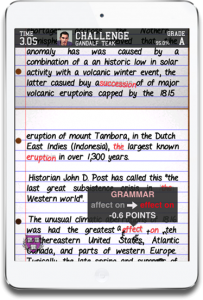 The Grading Game
The Grading Game
This game is a great example of taking a fairly mundane skill and making practice more engaging via game mechanics. It focuses on a common skill – writing – and creates a game out of learning how to do it better. The premise is simple; you are grading student papers, and it’s your job to find as many errors as possible. Part of the appeal is in the narrative it’s built around, which features humorous writing that is really well done. But it’s also a great example of game mechanics such as scoring, time constraints, leveling up, and more being used in a context in which the player is learning and building real-world skills.
Pac-Man 256
I add this to the list for two reasons. First, I’m a retro-gaming junkie, and things don’t get more retro-gaming than Pac-Man. But more importantly, I share this as an example of the “thinking outside the box” cliché. Pac-man is a fairly universal experience. Most of us have an expectation of what playing Pac-Man is like. But Pac-Man 256 takes that expectation and introduces a few new variables that make it fresh and new, while still being familiar. It’s a great example of breaking through expectations of what is to rethink existing content, an approach that we could adapt to repetitive learning experiences like compliance training.
 Star Walk
Star Walk
This popular app allows you to learn about astronomy and the stars. It combines a few of the themes we’ve discussed in other apps such as AR and experimentation, allowing users to point their camera at the sky and explore the infinite space around us. When I share this app with my kids, we don’t say “Let’s go learn about astronomy”; we say “It’s a clear night… Let’s go explore the stars”.
World of Goo
The last item on my list is one of my favorite games. It’s another sandbox game that, like Angry Birds, provides minimal instructions and allows you to explore on your own. It’s also a great example of problem solving, and the realistic physics applied to building goo-based structures really supports trail and error.
And Many More…
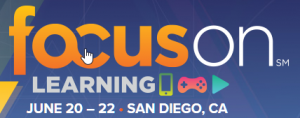 These are just a few of my favorites, but my list could easily go 10 times as long. I like to explore new games and apps and look at them through the lens of the questions I posed earlier. We’ve introduced a new program to our FocusOn Learning Conference to enable attendees to experience apps like these for themselves, and to engage in conversations with other professionals on how we can leverage the mechanics of the apps we use every day in our work.
These are just a few of my favorites, but my list could easily go 10 times as long. I like to explore new games and apps and look at them through the lens of the questions I posed earlier. We’ve introduced a new program to our FocusOn Learning Conference to enable attendees to experience apps like these for themselves, and to engage in conversations with other professionals on how we can leverage the mechanics of the apps we use every day in our work.
The Learning Arcade
 The experience is called The Learning Arcade, and it takes place exclusively at the FocusOn Learning Conference and Expo June 20-22 in San Diego. At the Learning Arcade you’ll be able to experience multiple apps and games (digital and analog) that can inspire your work as learning professionals. We’ll have multiple tablets with pre-installed games and apps available, as well as VR stations where you can try out HTC Vive, Oculus Rift, and Playstation VR. It’s a great opportunity to look at the apps we use every day in a new way, and to engage in conversations with your peers on how we can apply what we’re learning in our work.
The experience is called The Learning Arcade, and it takes place exclusively at the FocusOn Learning Conference and Expo June 20-22 in San Diego. At the Learning Arcade you’ll be able to experience multiple apps and games (digital and analog) that can inspire your work as learning professionals. We’ll have multiple tablets with pre-installed games and apps available, as well as VR stations where you can try out HTC Vive, Oculus Rift, and Playstation VR. It’s a great opportunity to look at the apps we use every day in a new way, and to engage in conversations with your peers on how we can apply what we’re learning in our work.
What Games or Apps do you Recommend?
We’re still building our list of games and apps to bring with us to the Learning Arcade. If you have a game or app you’d recommend we add to out list, please let us know by submitting it via the link below.
CLICK HERE TO SUGGEST A GAME!
See you in San Diego!

Leave a Reply